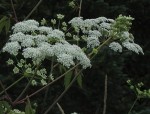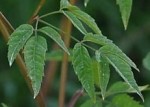 Water hemlock is also known by other names such as spotted parsley, poison parsley, and spotted cowbane. It belongs to the carrot family and is related to poison hemlock, parsnips, parsley, and Queen Anne’s Lace. Like poison hemlock, it is extremely toxic and is considered one of the most poisonous native North American plants; a small chunk of its root can cause death.
Water hemlock is also known by other names such as spotted parsley, poison parsley, and spotted cowbane. It belongs to the carrot family and is related to poison hemlock, parsnips, parsley, and Queen Anne’s Lace. Like poison hemlock, it is extremely toxic and is considered one of the most poisonous native North American plants; a small chunk of its root can cause death.
 This native biennial or perennial weed is found throughout the continental United States and is considered potentially invasive. It prefers full or part sun and moist to wet soil, so it grows well in irrigation ditches, along the banks of stream, in wet pastures, meadows, and woodlots, as well as in temporary swamps and marshes. When it is found in gardens it is not usually aggressive but should be removed because of its toxic nature.
This native biennial or perennial weed is found throughout the continental United States and is considered potentially invasive. It prefers full or part sun and moist to wet soil, so it grows well in irrigation ditches, along the banks of stream, in wet pastures, meadows, and woodlots, as well as in temporary swamps and marshes. When it is found in gardens it is not usually aggressive but should be removed because of its toxic nature.
 Description: Plants have smooth, hairless stems 3-6 feet tall that are hollow except at the nodes, and green streaked or spotted with purple near the base when mature. The alternate, hairless leaves clasp the stem and are 12” by 8” in size at the base of the plant, growing smaller as they ascend. Each leaf is double pinnately compound with each leaflet being 4” long and 1 ¼” wide. The leaflets have toothed margins and their veins run from the main vein to the notch between the teeth rather than the tips, a distinguishing characteristic of the plant. The upper parts of some of the stems bear small white flowers during the summer in compound umbels up to 6” across. Each umbel is flat-topped and consists of smaller umbels with 10-20 flowers each. Flowers are replaced by small, ribbed, tan to brown fruits. The roots are thick and fleshy and contain many liquid filled chambers. The roots are extremely poisonous.
Description: Plants have smooth, hairless stems 3-6 feet tall that are hollow except at the nodes, and green streaked or spotted with purple near the base when mature. The alternate, hairless leaves clasp the stem and are 12” by 8” in size at the base of the plant, growing smaller as they ascend. Each leaf is double pinnately compound with each leaflet being 4” long and 1 ¼” wide. The leaflets have toothed margins and their veins run from the main vein to the notch between the teeth rather than the tips, a distinguishing characteristic of the plant. The upper parts of some of the stems bear small white flowers during the summer in compound umbels up to 6” across. Each umbel is flat-topped and consists of smaller umbels with 10-20 flowers each. Flowers are replaced by small, ribbed, tan to brown fruits. The roots are thick and fleshy and contain many liquid filled chambers. The roots are extremely poisonous.

 Control: Water hemlock may be dug out wearing washable gloves because of the toxic nature of the plant. Because the plant thrives in wet places, its growth may be curtailed by restricting the moisture level of the area. Chemical control is most effective in late spring to early summer. Picloram and Dicamba with 2,4 D are especially useful.
Control: Water hemlock may be dug out wearing washable gloves because of the toxic nature of the plant. Because the plant thrives in wet places, its growth may be curtailed by restricting the moisture level of the area. Chemical control is most effective in late spring to early summer. Picloram and Dicamba with 2,4 D are especially useful.